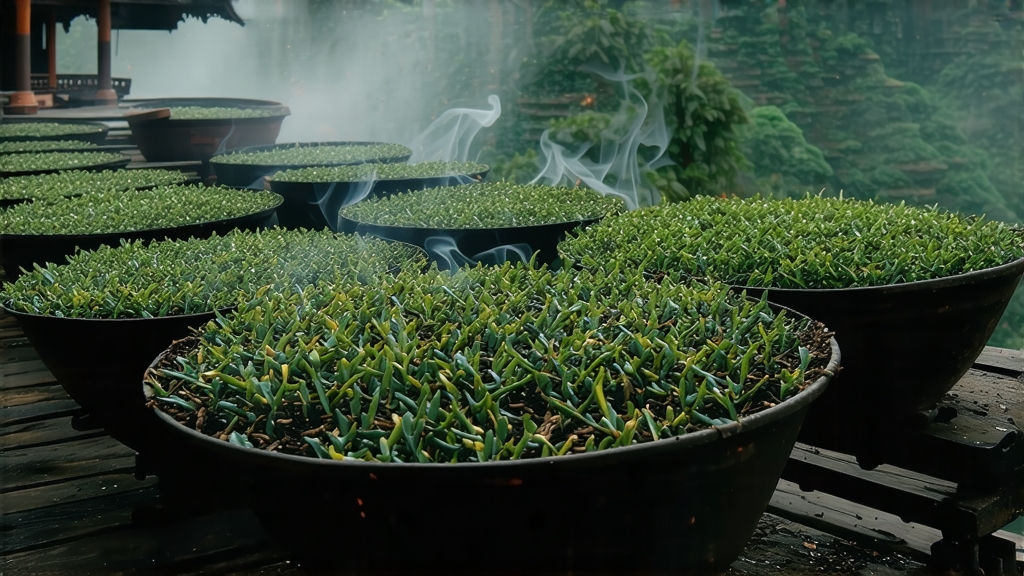
When European tea drinkers first encountered the dark, twisted leaves that produced a liquor as crimson as claret and a fragrance reminiscent of campfire and dried longan, they did not yet have a word for “black tea.” In the early seventeenth-century ports of Amsterdam and London the cargo was simply called “bohea,” a corruption of the Fujianese place-name Wuyi. Hidden within that commercial label was the original black tea of the world: Lapsang Souchong.
History: From Mountain Hermitage to Global Romance
Legend places the birth of Lapsang Souchong in the Tongmu Guan pass of the Wuyi range around 1568, late in the Ming dynasty. A passing army, so the story goes, commandeered a tea workshop, forcing farmers to speed-dry freshly picked leaves over available pine fires so that the crop would not spoil. The accidental smoke infusion proved popular with the next season’s Dutch buyers, and an industry was born. By the 1660s the British East India Company was listing “Souchon” at prices higher than green tea; Catherine of Braganza’s 1662 dowry chest that introduced tea to the English court almost certainly contained these very leaves. The name itself decodes the product: “souchong” refers to the fourth and fifth leaves down the shoot—larger, tougher foliage that tolerates heavy withering and smoke—while “lapsang” simply means “pine village.” Thus the tea is literally the pine-smoked large-leaf offering from Tongmu.
Micro-Terroirs within 120 km²
The Wuyi Biosphere Reserve is a karst landscape where subtropical mist alternates with short, sharp sunlight. Within Tongmu Guan, three micro-valleys—Marsong, Guadun, and Mutou—supply the most sought-after leaf. Marsong faces northeast, cooled by the Xixi Brook; its leaves acquire a cool menthol nuance. Guadun, at 900 m, traps morning fog that lengthens withering, deepening malt sweetness. Mutou, closest to the pine forests, gives the most resinous, almost turpentine top note. Outside the core zone, the broader Wuyi counties of Xingcun and Wufu produce “xiaozhong” (small-leaf souchong) that is still legally sold as Lapsang, though connoisseurs prize the 600–800 m elevation band inside the reserve where the original Da Bai (Big White) cultivar is interplanted with indigenous maoxie (hairy crab) bushes.
Craft: Smoke as Seasoning, Not Costume
Authentic Lapsang is not a finished tea that is merely “flavored” with smoke; the smoke is embedded during the final stage of craft. After the standard black-tea steps—plucking, solar withering on bamboo racks, rolling for cell rupture, and 90-minute oxidation in cedar-lined troughs—the leaves are spread 3 cm deep on hemp screens set over a pinewood pit fire. The fire is fed only with the heartwood of 40-year-old Chinese red pine (Pinus massoniana) that has been seasoned for six months; resinous green timber would yield bitter creosote. Temperature is held below 80 °C so that the leaves dry slowly, absorbing sweet phenols rather than harsh tars. Two firings of three hours each, separated by a 24-hour rest, create the classic “songyan xiang” (pine-smoke aroma). In the premium grade known as “unsmoked lapsang” or zhengshan xiaozhong, the same pine wood is burned in an adjoining room; warm air, not smoke, passes through a perforated wall, giving a whisper of resin that frames rather than dominates the honeyed malt.
Chemical Signature in the Cup
Gas-chromatography studies at the Fujian Academy of Agricultural Sciences identify guaiacol, 4-methylguaiacol, and syringol as the key volatile markers. These phenols bond with theaflavins formed during oxidation, yielding a crimson-orange liquor whose viscosity at 45 °C is 1.8 cP—thicker than most black teas yet lighter than Assam. The same study found that proper pine-smoke lowers caffeine by 7 % compared to oven-dried counterparts, explaining why even sensitive drinkers can enjoy two consecutive gongfu sessions without jitters.
Grades & Market Nomenclature
- Special Grade (tèjí): One bud